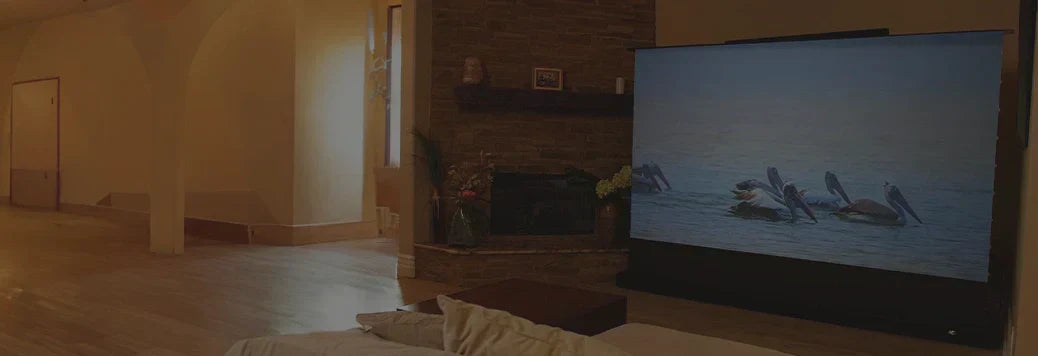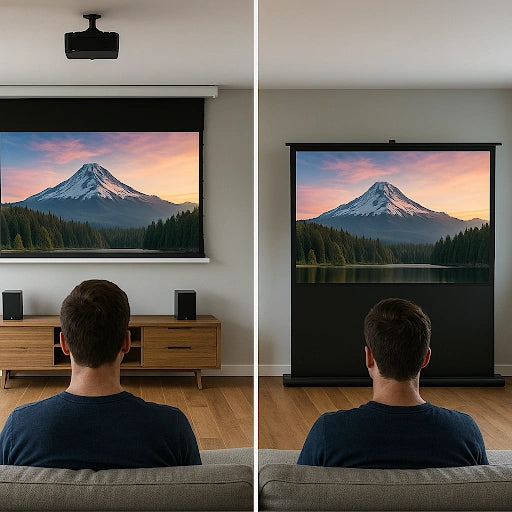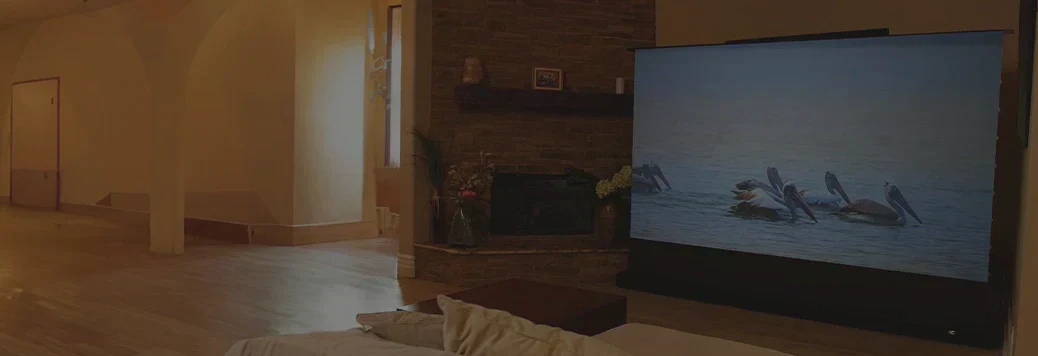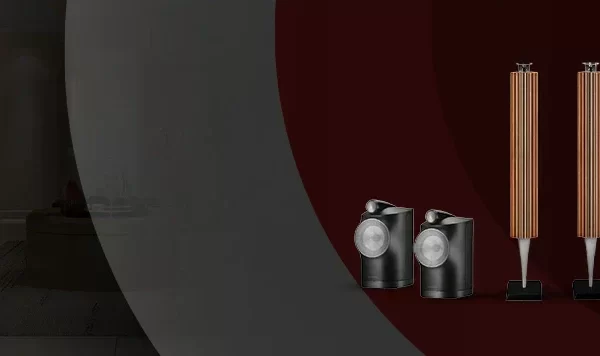
Picture this: a minimalist living room with no trace of AV gear in sight. You press a button and, like magic, a screen elegantly rises from the floor. No ceiling mounts, no wall installations, just clean lines and high-performance design. Welcome to the world of floor rising projector screens.
In luxury AV environments where aesthetics are as important as performance, a floor rising projector screen offers a compelling blend of form and function. Whether you’re outfitting a high-end home cinema, a modern boardroom or a multi-use media lounge, this screen type delivers cinematic scale without architectural compromise.
Let’s unpack what makes a floor rising projector screen special, how it works and when it makes the most sense in a premium setup.
What Is a Floor Rising Projector Screen?
A floor rising projector screen is a motorised or manual projection screen that lifts vertically from a base or housing installed on the floor. Unlike traditional fixed, wall-mounted or ceiling-drop screens, floor rising screens deploy upward, typically using tensioning systems to maintain a flat, ripple-free surface.
They are commonly used in spaces where:
- Ceiling mounting is impossible or undesirable
- Wall real estate is limited
- A clean, retractable screen solution is required
Premium models are engineered to match high-resolution projectors, offering ambient light rejection (ALR), ultra-flat tensioning and acoustically transparent fabrics.
How Does It Work?
Mechanism
Floor rising screens operate via two main mechanisms:
- Motorised Models: Feature a concealed electric motor that lifts the screen smoothly into position. Operation is often controlled via IR remote, RF remote or smart home integration.
- Manual Models: Use a scissor-lift or pneumatic mechanism to raise the screen manually, offering silent deployment and portability.
Once raised, the screen locks into place at a preset height, ensuring consistency in viewing geometry.
Screen Materials
High-end floor rising screens use specialised materials such as:
- ALR fabrics to combat ambient light in bright rooms
- Cinemascope or 16:9 aspect ratios to match content type
- Acoustic fabrics to hide centre speakers behind the screen
These materials are tensioned on all sides for an ultra-flat viewing surface.
Advantages vs Disadvantages at a Glance
| Features | Advantages | Disadvantages |
| Aesthetics | Clean, minimalist look when retracted | Housing unit may be visually obtrusive if not integrated into decor |
| Space Efficiency | Doesn’t occupy wall or ceiling space | Requires sufficient floor space and clear vertical path |
| Installation | No drilling into wallls or ceiling | May require levelling or reinforced flooring in some setups |
| Flexibility | Portable models can be relocated | Not as flush-mounted or permanent as in-wall/ceiling options |
| Screen Flatness & Quality | Premium versions offer tab-tensioned, ALR-compatible surfaces | Budget models may suffer from screen curling or lack of tension |
| Ease of Use | Motorised models offer seamless operation via remote or automation | Manual models lack the same polish or convenience |
| Maintenance & Durability | Enclosed design protects screen from dust and damage | Moving parts and motors require occasional servicing |
| Cost Considerations | Competitive compared to custom in-wall solutions | Premium variants still carry a higher price tag |

Caption: A side-by-side photographic comparison of two home theatre setups — one with a ceiling-mounted projector screen and the other with a floor-rising projector screen. The image highlights the visual and spatial impact of each solution, showing how floor-rising screens blend seamlessly into minimalist interiors while ceiling-mounted screens suit rooms with traditional AV setups.
Use-Cases for High-End AV Buyers
Home Theatres with Style Constraints
If your home cinema shares space with a living room or doubles as a lounge, floor rising screens provide big-screen visuals without the permanence of a traditional installation.
Boardrooms and Presentation Spaces
Professional environments benefit from quick deployment and the ability to maintain a clean aesthetic between meetings.
Heritage or Architecturally Sensitive Buildings
Where ceiling or wall alterations are not allowed, these screens enable high-end AV integration without structural intervention.
Designer Homes with UST Projectors
Match a floor rising screen with a designer UST projector to create an ultra-modern media setup that blends seamlessly into your space.
Integrating Floor Rising Screens into Smart Home Ecosystems
In today’s high-end AV environments, the screen is no longer a standalone accessory—it’s part of an intelligent, integrated experience. Floor rising projector screens, particularly motorised models, are now being engineered to sync effortlessly with broader home automation systems, elevating not just the aesthetics but also the functionality of your AV setup.
Whether you use Control4, Crestron, Savant or Lutron, premium floor rising screens can be configured to deploy automatically when a film is queued, lights are dimmed or a preset AV scene is activated. For example, you could create a “Movie Night” scene that triggers your AV receiver, lowers the lights to 20%, powers up the projector and gracefully raises the screen into viewing position—all at the touch of a button or voice command.
Advanced options even include feedback sensors, which detect screen positioning and relay status updates to your control system, ensuring precise synchronisation. This is particularly valuable in professional-grade home theatres or mixed-use living spaces where timing and automation matter.
Some models also support RS-232 or IP-based control protocols, giving integrators flexibility in wiring and remote diagnostics. This is ideal for high-net-worth homeowners or commercial users who demand both style and infrastructure-grade reliability.
If you’re already investing in smart blinds, acoustic treatments and climate control—a floor rising screen is a natural extension of your connected ecosystem. Not only does it maintain the minimalist look you’re curating, but it ensures your visual experience is always a seamless part of the broader environment.
For AV professionals and enthusiasts alike, integrating a motorised floor rising screen into your smart home isn’t just about convenience—it’s about delivering cinematic immersion with architectural elegance. And in premium setups, that’s exactly what sets the good apart from the truly exceptional.
A Quick Comparison Table
| Features | Floor Rising Screen | Fixed-Frame Screen | Ceiling Drop-Down Screen |
| Installation Requirements | Minimal | Permanent | Ceiling cavity or bracket |
| Aesthetic Integration | High | Moderate | High |
| Portability | High (manual models) | None | Low |
| Screen Flatness | Excellent (tensioned) | Excellent | Good (depends on design) |
| ALR Compatibility | Yes (premium models) | Yes | Yes |
| Motorised Option | Yes | No | Yes |
Things to Consider Before Buying
- Projector Compatibility: Not all screens work well with UST projectors. Ensure screen size, gain and viewing angle suit your device.
- Deployment Speed: If you need rapid deployment, motorised models are faster and quieter.
- Room Dimensions: Measure carefully—especially height clearance for full screen extension.
- Control Options: Choose between remote, wall switch or smart integration for daily convenience.k
- Material Quality: Opt for screens that are ISF-certified or reference grade for best performance.
Final Thoughts: When Elegance Meets Engineering
Floor rising projector screens are a masterclass in design-driven AV thinking. They combine premium screen technology with a discreet aesthetic that complements luxury spaces. While they may come at a premium, the blend of flexibility, performance and minimalism makes them well worth the investment.






